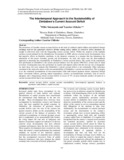Please use this identifier to cite or link to this item:
https://cris.library.msu.ac.zw//handle/11408/1431| Title: | The intertemporal approach to the sustainability of Zimbabwe's current account deficit | Authors: | Nakunyada, Willie Chikoko, Laurine |
Keywords: | Current account deficit, current account sustainability, inter-temporal approach, balance of payments, trade balance, capital account. | Issue Date: | 2012 | Publisher: | Scholarlink Research Institute Journals | Series/Report no.: | Journal of Emerging Trends in Economics and Management Sciences;Vol. 3, No. 6; p. 997-1006 | Abstract: | The recurrence of sizeable current account deficits on the back of subdued capital inflows and depleted foreign exchange reserves has generated extensive debates among policy makers as corrective policy measures are sought to effectively deal with the burgeoning current account deficit. Within the auspices of the multiple currency system adopted by the Zimbabwean Government in 2009, adverse external sector developments have had negative effects on liquidity conditions in the domestic economy in a manner that has hamstrung the attainment of fast paced economic growth and development. As such, this study uses the Inter-temporal approach to determine the sustainability of Zimbabwe’s current account deficit. The results of the stationarity tests performed on Zimbabwe’s the current account balance over the period 1990-2012, reveals lack of mean reversion. Cointegration tests also performed on exports and imports reflect that the two are not co-integrated. As such, these two tests indicate that Zimbabwe’s current account deficit is not sustainable. Other indicators examined in the study also attests to the non-sustainability of Zimbabwe’s current account deficit. This is largely so as the continued accumulation of non-concessionary debt and external payment arrears, depressed foreign direct investment inflows, growing import dependency, reliance on humanitarian assistance, lack of reserve adequacy and a burgeoning current account deficit in excess of 5% of gross domestic product all point to a current account deficit that is not sustainable. | URI: | http://hdl.handle.net/11408/1431 | ISSN: | 2141-7024 |
| Appears in Collections: | Research Papers |
Files in This Item:
| File | Description | Size | Format | |
|---|---|---|---|---|
| The Intertemporal Approach.pdf | Full Text | 894.64 kB | Adobe PDF |  View/Open |
Page view(s)
116
checked on Jan 14, 2025
Download(s)
108
checked on Jan 14, 2025
Google ScholarTM
Check
Items in MSUIR are protected by copyright, with all rights reserved, unless otherwise indicated.


